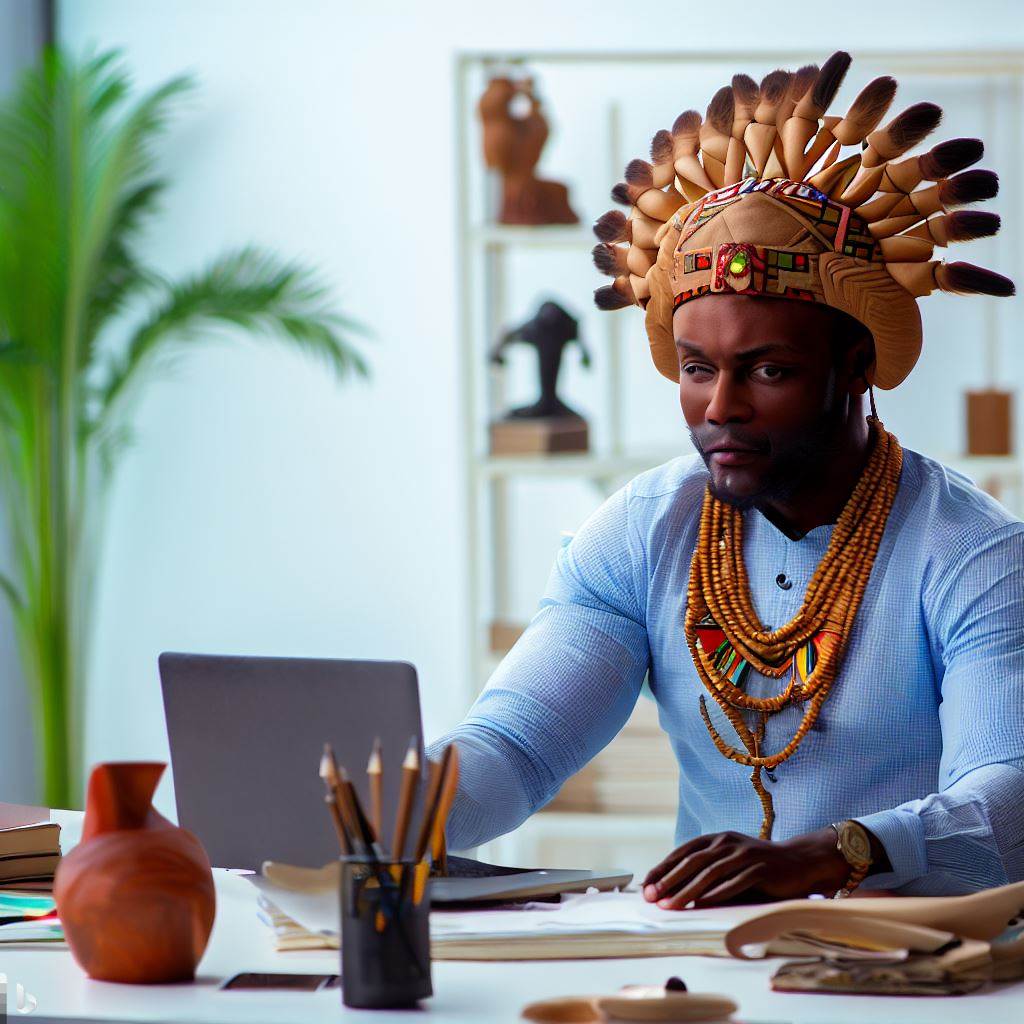Introduction
Production design ethics and best practices in Nigeria is a crucial topic in the film industry.
Ethics and Best Practices in Production Design within the Nigerian Context delves into the crucial considerations and standards guiding creative production design in Nigeria’s vibrant and diverse entertainment industry.
This exploration navigates the intersection of ethics and aesthetics, shedding light on the responsible and impactful role of production design in shaping narratives and cultural representations.
Discussing this topic is significant in the context of the Nigerian film industry’s growth and development.
Understanding Production Design in Nigeria
Define production design and its significance in filmmaking
Production design encompasses the creation of visual elements in films. It involves designing and constructing sets, selecting props, choosing costumes, and creating the overall aesthetic.
In filmmaking, production design plays a crucial role in storytelling and enhancing the audience’s cinematic experience.
It sets the mood, creates a sense of time and place, and helps develop characters. Through production design, filmmakers can effectively convey emotions, themes, and messages.
Provide an overview of the Nigerian film industry and its growth
The Nigerian film industry, popularly known as Nollywood, is the second-largest film industry globally. It produces thousands of movies annually, predominantly in the English language.
Nollywood emerged in the 1990s and has experienced remarkable growth over the years. With a strong domestic market and international recognition, Nollywood has become a significant cultural and economic force.
This growth has opened doors for various professionals, including production designers, to showcase their talent and contribute to the industry.
Discuss the unique challenges and opportunities for production design in Nigeria
Nigeria’s diverse cultural heritage poses both challenges and opportunities for production design. The country’s rich traditions, customs, and vibrant aesthetics provide a vast pool of inspiration.
However, incorporating these diverse elements into the design while maintaining authenticity can be challenging. Budget constraints often limit the resources available for production design in Nigeria.
Production designers must be creative and resourceful, finding innovative ways to achieve their vision within limited means.
The climate and geographical diversity in Nigeria also present unique challenges for outdoor set design. Harsh weather conditions and varying landscapes necessitate careful planning and adaptation.
Despite these challenges, production design in Nigeria offers immense opportunities for growth and recognition. There is a growing demand for high-quality Nigerian cinema both domestically and internationally.
Production designers can showcase the richness of Nigerian culture and contribute to the narrative of African storytelling.
Moreover, advancements in technology and increased investment in the industry provide access to better tools and resources.
In short, production design is a vital aspect of filmmaking in Nigeria. It is responsible for creating visually captivating and authentic storytelling experiences.
Nigerian cinema, with its rapid growth and global recognition, showcases the importance of production design in shaping the industry’s success.
While facing unique challenges, production designers in Nigeria have the opportunity to leverage the country’s cultural diversity and contribute to the narrative of African storytelling.
Read: Networking for Production Designers in Nigeria
Ethical Considerations in Production Design
Discuss the ethical responsibilities of production designers
Production designers have a responsibility to accurately represent cultures and communities. They should ensure that their designs are not offensive or disrespectful towards any group.
Production designers must prioritize diversity and inclusion in their creative processes. They should strive to create environments that are safe and comfortable for all cast and crew members.
It is the ethical duty of production designers to adhere to copyright laws and avoid plagiarism. They should respect the privacy of individuals and not use personal information without consent.
Production designers should maintain the confidentiality of sensitive materials and designs. They must ensure that their designs comply with health and safety regulations.
Designers should promote sustainability and minimize environmental impact in their designs. They have a responsibility to collaborate and communicate effectively with other departments.
Explore the potential ethical dilemmas in the production design process in Nigeria
- The use of cultural symbols and motifs without proper understanding or respect for their significance can be ethically problematic.
- Portraying certain communities or ethnic groups in a stereotypical or negative manner may raise ethical concerns.
- Production designs that perpetuate harmful gender roles or promote discrimination can be highly controversial.
- Not providing equal opportunities for local artists and craftsmen in the production design industry can lead to ethical dilemmas.
- If production designers knowingly collaborate with unethical suppliers or use materials obtained through illegal means, it raises ethical issues.
- Disregarding the input and concerns of local communities when creating set designs can be ethically problematic.
- Creating excessively extravagant sets and designs, which contribute to wastefulness, can be seen as unethical.
Provide examples of ethical practices followed by production designers in Nigeria
- Engaging in thorough research and consultation with cultural experts to ensure accurate representation of communities.
- Collaborating with local artisans and craftsmen, supporting the local economy and preserving traditional craftsmanship.
- Promoting diversity on set by hiring a diverse cast and crew and encouraging respectful collaboration.
- Adopting sustainable practices in set construction and materials sourcing to minimize environmental impact.
- Respecting intellectual property rights and giving credit to artists and designers for their work.
- Creating inclusive and safe working environments that prioritize the well-being of all individuals involved.
- Engaging in open and transparent communication with local communities, addressing concerns and incorporating their feedback.
- Avoiding cultural appropriation and using cultural symbols and motifs responsibly and respectfully.
Read: Apprenticeships in Production Design in Nigeria

Best Practices in Production Design
Highlight the key elements of effective production design
- Attention to detail is crucial in creating a visually captivating production design.
- The use of color, texture, and lighting helps in setting the mood and tone of a scene.
- Understanding the script and characters is essential to design an appropriate environment.
- Effective production design enhances the storytelling and complements the narrative.
- The ability to work within the given budget and time constraints is important.
- A well-organized and efficient workflow ensures the successful execution of production design.
Discuss the role of research and creative inspiration in production design
Research plays a vital role in production design as it helps in creating authentic and believable worlds.
- Thorough research allows designers to gain knowledge about different time periods, cultures, or specific locations.
- Studying existing visual references and artistic styles provides creative inspiration for designing original sets.
- Research ensures that the production design contributes to the overall authenticity and credibility of the project.
- Creative inspiration fuels innovation and helps production designers bring unique and fresh ideas to their work.
- Combining research and creative inspiration enables designers to bring the director’s vision to life effectively.
Explore the importance of collaboration and communication among production team members
Collaboration and communication are essential for a cohesive and harmonious production design process.
- Regular communication between the director, production designer, and other key stakeholders ensures alignment.
- Sharing ideas, concepts, and sketches fosters a collaborative and creative environment within the team.
- Collaboration allows for effective problem-solving and the exploration of different design possibilities.
- Clear communication ensures that everyone involved understands the vision and goals of the production design.
- Collaboration and communication promote teamwork and enable the successful execution of the design.
In essence, effective production design requires attention to detail, the use of color and lighting, and understanding the script and characters.
Research and creative inspiration play crucial roles in creating authentic and visually engaging designs.
Collaboration and communication among production team members are vital for a cohesive and successful production design process.
Read: Tools Every Production Designer Needs in Nigeria
Delve into the Subject: Building a Portfolio: Tips for Nigerian Interior Designers
Sustainable and Eco-friendly Production Design
Explain the concept of sustainable production design
Sustainable production design focuses on creating film sets and props that have minimal negative environmental impact.
Discuss the environmental impact of production design and ways to minimize it
Production design can contribute to pollution and waste, but precautions can be taken to minimize its environmental impact. These include:
- Using eco-friendly materials: Opt for sustainable and biodegradable materials instead of harmful chemicals and plastics.
- Efficient energy use: Implement energy-efficient lighting and equipment to reduce power consumption on set.
- Waste management: Implement proper waste management practices, such as recycling and reducing the use of disposable items.
- Transportation: Encourage carpooling and use eco-friendly vehicles to reduce carbon emissions during transportation to and from the set.
- Consider location: Choose filming locations that have minimal impact on the environment, such as natural settings or sustainable buildings.
Showcase examples of sustainable production design practices in Nigeria
Nigeria has started to adopt sustainable production design practices. Here are a few examples:
- ‘The Milkmaid‘: This Nigerian film used eco-friendly materials for set construction and encouraged sustainable practices throughout the production process.
- ‘Eyimofe‘: The production team used recycled and upcycled materials for set design, promoting creative sustainability.
- ‘Green White Green‘: The film incorporated sustainable storytelling by highlighting environmental issues in Nigeria, encouraging viewers to consider sustainable practices.
- Nollywood Green Alliance: This initiative promotes eco-friendly practices within the Nigerian film industry, raising awareness among filmmakers and encouraging sustainable production design.
These examples demonstrate the growing interest in sustainable production design in Nigeria and the potential for positive environmental impact.
By implementing sustainable production design practices, Nigeria can reduce its carbon footprint, contribute to environmental conservation, and inspire other industries to adopt eco-friendly approaches.
With increasing awareness and collaboration, the Nigerian film industry can become a pioneer in sustainable and eco-friendly production design.
Read: Freelancing as a Production Designer in Nigeria’s Scene
Case Studies: Outstanding Production Design in Nigerian Films
Analyze successful Nigerian films with notable production design
- “The Figurine” directed by Kunle Afolayan showcases exceptional production design choices.
- The film’s sets, costumes, and props exhibit a high level of attention to detail.
- The production team successfully created a visually captivating world that enhances the storytelling.
- “The Figurine” demonstrates the importance of thoughtful production design in Nigerian cinema.
Examine how these films adhere to ethical practices and employ best production design techniques
- Nigerian films with outstanding production design prioritize ethical practices.
- Production designers ensure the authenticity and cultural sensitivity of the film’s visual elements.
- Respect for local customs and traditions is crucial in portraying Nigerian culture accurately.
- These films employ best practices by collaborating with local artisans and craftsmen.
- The use of eco-friendly materials and sustainable practices is also considered.
- The focus on ethical and best production design techniques elevates the quality of Nigerian films.
Highlight the impact of outstanding production design on the overall film experience
- Outstanding production design enhances the audience’s immersion in the film’s world.
- Attention to detail creates a more believable and engaging cinematic experience.
- Well-designed sets and props contribute to character development and storytelling.
- Production design can effectively evoke emotions and establish the film’s tone.
- The visual aesthetics of a film play a significant role in audience enjoyment and appreciation.
- Outstanding production design elevates the overall quality and appeal of Nigerian films.
In a nutshell, Nigerian films with outstanding production design not only showcase exceptional creativity but also adhere to ethical practices and employ the best design techniques.
Through analyzing successful films like “The Figurine,” it becomes evident that attention to detail and cultural sensitivity are crucial in creating visually captivating worlds.
By highlighting the impact of outstanding production design on the overall film experience, it becomes apparent that it enhances audience immersion and contributes to character development.
Ultimately, the significance of production design in Nigerian cinema cannot be underestimated, as it elevates the quality and appeal of films while portraying Nigerian culture accurately and ethically.
Conclusion
In summary, this blog post highlighted the key points regarding ethics and best practices in production design in Nigeria.
The significance of ethics and best practices in production design for the Nigerian film industry cannot be underestimated.
It is crucial to encourage ongoing discussions and continuous improvements in production design practices for the growth and success of the industry.




